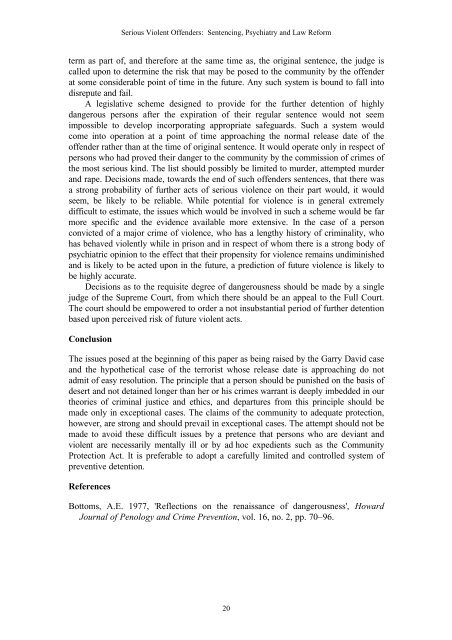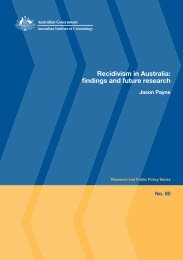Coping with the highly dangerous : issues of principle raised by ...
Coping with the highly dangerous : issues of principle raised by ...
Coping with the highly dangerous : issues of principle raised by ...
You also want an ePaper? Increase the reach of your titles
YUMPU automatically turns print PDFs into web optimized ePapers that Google loves.
Serious Violent Offenders: Sentencing, Psychiatry and Law Reform<br />
term as part <strong>of</strong>, and <strong>the</strong>refore at <strong>the</strong> same time as, <strong>the</strong> original sentence, <strong>the</strong> judge is<br />
called upon to determine <strong>the</strong> risk that may be posed to <strong>the</strong> community <strong>by</strong> <strong>the</strong> <strong>of</strong>fender<br />
at some considerable point <strong>of</strong> time in <strong>the</strong> future. Any such system is bound to fall into<br />
disrepute and fail.<br />
A legislative scheme designed to provide for <strong>the</strong> fur<strong>the</strong>r detention <strong>of</strong> <strong>highly</strong><br />
<strong>dangerous</strong> persons after <strong>the</strong> expiration <strong>of</strong> <strong>the</strong>ir regular sentence would not seem<br />
impossible to develop incorporating appropriate safeguards. Such a system would<br />
come into operation at a point <strong>of</strong> time approaching <strong>the</strong> normal release date <strong>of</strong> <strong>the</strong><br />
<strong>of</strong>fender ra<strong>the</strong>r than at <strong>the</strong> time <strong>of</strong> original sentence. It would operate only in respect <strong>of</strong><br />
persons who had proved <strong>the</strong>ir danger to <strong>the</strong> community <strong>by</strong> <strong>the</strong> commission <strong>of</strong> crimes <strong>of</strong><br />
<strong>the</strong> most serious kind. The list should possibly be limited to murder, attempted murder<br />
and rape. Decisions made, towards <strong>the</strong> end <strong>of</strong> such <strong>of</strong>fenders sentences, that <strong>the</strong>re was<br />
a strong probability <strong>of</strong> fur<strong>the</strong>r acts <strong>of</strong> serious violence on <strong>the</strong>ir part would, it would<br />
seem, be likely to be reliable. While potential for violence is in general extremely<br />
difficult to estimate, <strong>the</strong> <strong>issues</strong> which would be involved in such a scheme would be far<br />
more specific and <strong>the</strong> evidence available more extensive. In <strong>the</strong> case <strong>of</strong> a person<br />
convicted <strong>of</strong> a major crime <strong>of</strong> violence, who has a lengthy history <strong>of</strong> criminality, who<br />
has behaved violently while in prison and in respect <strong>of</strong> whom <strong>the</strong>re is a strong body <strong>of</strong><br />
psychiatric opinion to <strong>the</strong> effect that <strong>the</strong>ir propensity for violence remains undiminished<br />
and is likely to be acted upon in <strong>the</strong> future, a prediction <strong>of</strong> future violence is likely to<br />
be <strong>highly</strong> accurate.<br />
Decisions as to <strong>the</strong> requisite degree <strong>of</strong> <strong>dangerous</strong>ness should be made <strong>by</strong> a single<br />
judge <strong>of</strong> <strong>the</strong> Supreme Court, from which <strong>the</strong>re should be an appeal to <strong>the</strong> Full Court.<br />
The court should be empowered to order a not insubstantial period <strong>of</strong> fur<strong>the</strong>r detention<br />
based upon perceived risk <strong>of</strong> future violent acts.<br />
Conclusion<br />
The <strong>issues</strong> posed at <strong>the</strong> beginning <strong>of</strong> this paper as being <strong>raised</strong> <strong>by</strong> <strong>the</strong> Garry David case<br />
and <strong>the</strong> hypo<strong>the</strong>tical case <strong>of</strong> <strong>the</strong> terrorist whose release date is approaching do not<br />
admit <strong>of</strong> easy resolution. The <strong>principle</strong> that a person should be punished on <strong>the</strong> basis <strong>of</strong><br />
desert and not detained longer than her or his crimes warrant is deeply imbedded in our<br />
<strong>the</strong>ories <strong>of</strong> criminal justice and ethics, and departures from this <strong>principle</strong> should be<br />
made only in exceptional cases. The claims <strong>of</strong> <strong>the</strong> community to adequate protection,<br />
however, are strong and should prevail in exceptional cases. The attempt should not be<br />
made to avoid <strong>the</strong>se difficult <strong>issues</strong> <strong>by</strong> a pretence that persons who are deviant and<br />
violent are necessarily mentally ill or <strong>by</strong> ad hoc expedients such as <strong>the</strong> Community<br />
Protection Act. It is preferable to adopt a carefully limited and controlled system <strong>of</strong><br />
preventive detention.<br />
References<br />
Bottoms, A.E. 1977, 'Reflections on <strong>the</strong> renaissance <strong>of</strong> <strong>dangerous</strong>ness', Howard<br />
Journal <strong>of</strong> Penology and Crime Prevention, vol. 16, no. 2, pp. 70–96.<br />
20















